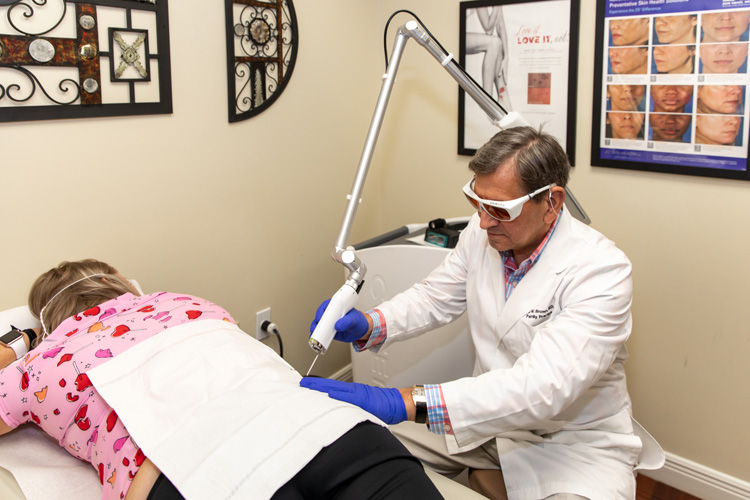
Think before you ink. Getting rid of a tattoo can be a tricky – and sometimes risky – business.
Passions, emotional entanglements, religious or political fervors and a host of other reasons can make getting a tattoo seem like a good idea, but, as Jimmy Buffett has said, tattoos often are “a permanent reminder of a temporary feeling.”
Nobody knows that better than Dr. Hal Brown at Reflections Aesthetic and Laser Solutions here in Vero Beach. He specializes in using the latest, high-powered laser technology to remove now-unwanted tattoos.
Asked if there was such a thing as a “typical” tattoo-removal patient, the soft-spoken Brown pauses briefly and says, “We have quite a spectrum here. We have young folks that either regret the tattoo that they’d chosen, or they are entering the workforce in a job that doesn’t accept see-able or visible tattoos.
“Many companies – including the hospital here – like tattoos to be covered when you’re at work and sometimes people have those tattoos on their fingers and on their neck where they can be seen, so those kinds of folks often come in for a tattoo removal.
“Airlines and the military,” Brown continues, “don’t like visible tattoos. We also get 40- and 50-year-olds who regret what they did when they were younger and we have some older people that have just lived with it for a long time and are just ready to get it removed.”
The good news? Tattoo removal today is safer and less painful than it was in the past.
The oldest forms of tattoo removal were incredibly painful, involving non-surgical steel blades attempting to cut and peel away individual layers of living skin until the tattoo ink was no longer visible.
That approach often failed and left the patient with one or more debilitating – and sometimes lethal – infections.
More recently, nanolaser treatments offered somewhat safer but still less-than-ideal removal results. That’s in large part, Brown says, because nanolasers are limited by the colors of ink they can break down.
“They work OK with black ink, but not with other colors,” Brown says. And they often take more than 18 sessions to remove a tattoo and that results in “more trauma to the skin” and frequently leave very noticeable scars where the tattoo once was.
The American Society for Dermatologic Surgery has one pointed piece of advice for those seeking to remove a tattoo: “Find the right doctor. Choose someone qualified to perform tattoo removal procedures who also has the right laser equipment.”
Brown fills both those requirements.
In addition to being the medical director at Reflections Aesthetics & Laser Solutions, Brown is chief of staff at Cleveland Clinic Indian River Hospital as well as a longtime primary care physician at Primary Care of the Treasure Coast.
Still, he gives most of the credit for his tattoo-removal prowess to his equipment.
“I think the important thing is that this newer technology treats all skin types and all tattoo colors in a fast, efficient fashion so there are fewer treatments required and less tissue damage occurs.”
“It’s very important,” Brown elaborates, “to choose the right technology and not go for the cheap upfront costs that are maybe performed by non-physicians. There are all kinds of lasers on the market and all different kinds of people are using those lasers.”
The laser Brown employs uses extremely short, high-powered “picosecond” pulses.
A “picosecond” is one-trillionth of a second and about 1,000 times faster than those earlier nanosecond machines. It’s also FDA-approved for tattoo removal.
Asked if he’s had any experience with patients who first tried a storefront nanosecond tattoo removal procedure, Brown sighs and quietly says, “Sure. In fact I had one in today. She had a partially treated tattoo at a different center with a poor-quality laser and she wasn’t getting the results she wanted so she came here for additional treatments.
“It happens quite a bit. Inferior technology doesn’t produce [good] results and it doesn’t completely get rid of the tattoo,” Brown said.
Depending on the size and colors in the tattoo to be removed, it can take between four and eight sessions for Brown to make those ‘permanent reminders of a temporary feeling’ disappear. That’s half or less than the number of visits most other tattoo removal procedures require.
Dr. Hal Brown is with Reflections Aesthetic & Laser Solutions at 1265 36th Street, Suite C in Vero Beach. The phone number is 772-567-7196. Brown also is chief of staff at Cleveland Clinic Indian River Hospital. n



